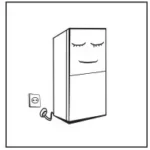

USER’S MANUAL
HR113W
To request a service call
Tel. 01759 487830
Or visit
www.appliancesupport.co.uk
Safety warnings
Warning
Warning: risk of fire! flammable materials
This appliance is intended to be used in household and similar applications such as staff kitchen areas In shops, offices and other working environments: farm houses and by clients in hotels, motels and other residential type environments: bed and breakfast type environments: catering and similar non-retail applications.
IF the supply cord is damaged, it must be replaced by the manufacturer, its service agent or similarly qualified persons in order to avoid a hazard.
DO not store explosive substances such as aerosol cans with a flammable propellant In this appliance.
THE appliance has to be unplugged after use and before carrying out user maintenance on the appliance.
WARNING: Keep ventilation openings, in the appliance enclosure or in the built-in structure. clear of obstruction.
WARNING: Do not use mechanical devices or other means to accelerate the defrosting process. other than those recommended by the manufacturer.
WARNING: Do not damage the refrigerant circuit.
WARNING: Do not use electrical appliances inside the food storage compartments of the appliance, unless they are of the type recommended by the manufacturer.
WARNING: Please abandon the appliance according to local regulators for it use of flammable blowing gas and refrigerant
WARNING: When positioning the appliance, ensure the supply cord is not trapped or damaged.
WARNING: Do not locate multiple portable socket outlets or portable power supplies at the Mar of the appliance.
DO not use extension cords or ungrounded ( two-prong ) adapters.
DANGER: Risk of child entrapment. Before you throw away the appliance:
- Take off the doors.
- Leave the shelves in place so that children may not easily climb inside.
THE appliance must be disconnected from the source of the electrical supply before attempting the installation of the accessory.
REFRIGERANT and cyclopentane foaming material used for the appliance are flammable. Therefore, when the appliance is scrapped, it shall be kept away from any fire source and be recovered by a special recovering company with a corresponding qualification other than being disposed of by combustion, so as to prevent damage to the environment or any other harm.
FOR EN standard: This appliance can be used by children aged from 8 years and above and persons with reducing physical sensory or mental capabilities or lack of experience and knowledge if they have been given supervision or instruction concerning use of the appliance in a safe way and understand the hazards involved. Children shall not play with the appliance. Cleaning and user maintenance shall not be made by children without supervision. Children aged from 3 to 8 years are allowed to load and unload refrigerating appliances.
FOR IEC standard: This appliance is not intended for use by persons (including children) with reduced physical, sensory or mental capabilities, or lack of experience and knowledge, unless they have been given supervision or instruction concerning the use of the appliance by a person responsible for their safety.)
CHILDREN should be supervised to ensure that they do not play with the appliance. TO avoid contamination of food, please respect the following instructions:
- Opening the door for long periods can cause a significant increase of the temperature in the compartments of the appliance.
- Clean regular surfaces that can come in contact with food and accessible drainage systems.
- Clean water tanks if they have not been used for 48 h; flush the water system connected to a water supply if water has not been drawn for 5 days. (note 1)
- Store raw meat and fish in suitable containers in the refrigerator, so that it is not in contact with or drip onto other food.
- Two-star ** frozen-food compartments are suitable for storing pre-frozen food, storing or making ice cream, and making ice cubes. (note 2)
- One * -, two **: -and three-star if *i compartments are not suitable for the freezing of fresh food. (note 3)
- If the refrigerating appliance is left empty for long periods, switch off, defrost, clean, dry, and leave the door open to prevent mold from developing within the appliance.
Note 1,2,3: Please confirm whether it is applicable according to your product compartment type.
INSTALLATION
Location
When selecting a position for your unit you should make sure the floor is flat and firm, and the room is well ventilated. Avoid locating your unit near a heat source, e.g. cooker, boiler or radiator. Also avoid direct sunlight as it may increase electrical consumption. Extreme cold ambient temperatures may also cause the unit not to perform properly. This unit is not designed for use in a garage or outdoor installation. Do not drape the unit with any covering. When installing the unit, ensure that 20 cm of free space is left at both sides, 15 cm at the rear and 20 cm at the top of the unit. This will allow cold air to circulate around the Fridge Freezer and improve the efficiency of the cooling process. The door can be opened to the right or the left, depending on what better suits the location. Please ensure there is adequate space for the door to fully open.
Reversing the Door Swing(optional)
Tools Required: Phillips style screwdriver / Flat blade screwdriver / Hexagonal spanner
 If you want to have the door swing reversed, we recommend that you contact a qualified technician. You should only try to reverse the door yourself if you believe that you are qualified to do so.
If you want to have the door swing reversed, we recommend that you contact a qualified technician. You should only try to reverse the door yourself if you believe that you are qualified to do so.- Ensure the unit is unplugged and empty.
- Adjust the two leveling feet to their highest position.
- To take the door of it is necessary to tilt the unit backward. You should rest the unit on something solid so that it will not slip during the door reversing process.
- All parts removed must be saved to do the reinstallation of the door.
- Do not lay the unit fat as this may damage the coolant system.
- We recommend that 2 people handle the unit during assembly.
1) Start by removing the bracket from the bottom of the refrigerator. Unscrew the two screws from the bottom bracket. Remove the foot from the opposite side.

2) Self-Tapping Screws/Bottom Bracket/Foot
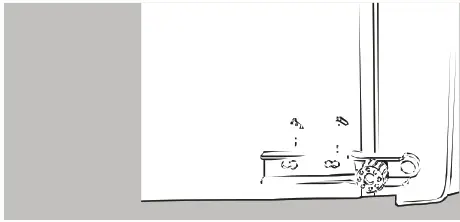 3) Slide the door down, away from the hinge pin located on the top of the door.
3) Slide the door down, away from the hinge pin located on the top of the door.
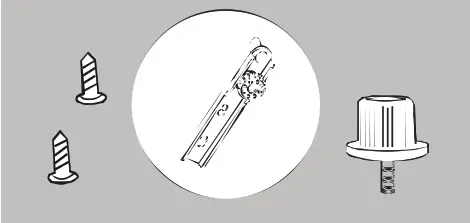
4) Remove the plastic cover from the door hinge first. Then unscrew the two screws from top bracket and replace on the other side.
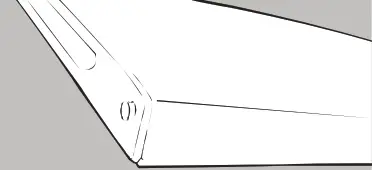
5) To install the bracket on the left side of the appliance, screw the two screws through the bracket and into the top of the appliance.Slide the door back onto the top hinge. Ensure the door is face up. Replace the plastic cover on the top bracket by pressing down until it clicks into position.
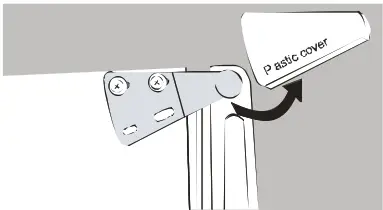
6) Screw the bottom hinge into place on the new side. Replace the foot on the other side.
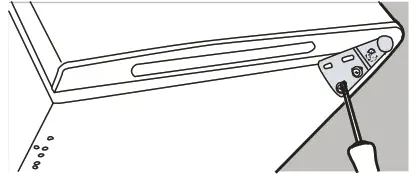
7) Check that the door is aligned horizontally and vertically and that the seals are closed on all sides before finally tightening the bottom hinge. Readjust the leveling feet.
(The picture above is only for reference. The actual configuration will depend on the physical product or statement by the distributor)
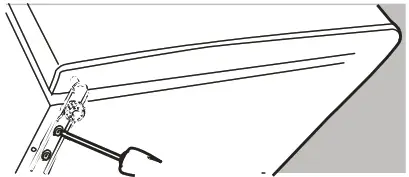
Door Space Requirements
The unit’s door must be able to open fully as shown. W×D≥800mm×780mm

Leveling the Unit
To do this adjust the two leveling feet at the front of the unit. If the unit is not level, the door and magnetic seal alignments will not be covered properly.
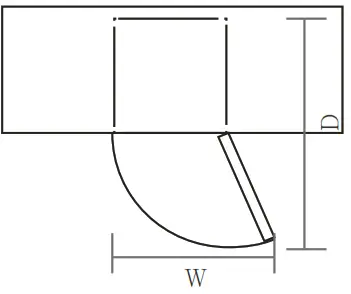
Cleaning Before Use
Wipe the inside of the unit with a weak solution of bicarbonate soda. Then rinse with warm water using a ‘Wrung-out’ sponge or cloth. Wash the shelves and salad bin in warm soapy water and dry completely before replacing in the unit. Clean the exterior of the unit with a damp cloth. If you require more information refer to the Cleaning section.
Before Using Your Unit
Before placing any food in your unit, turn it on and wait for 24 hours, to make sure it is working properly and to allow it time to fall to the correct temperature. Your unit should not be overfilled.
![]()
- Before Plugging in
You must check that you have a socket that is compatible with the plug supplied with the unit. - Before Turning On!
Do not turn on until two hours after moving the unit. The coolant fluid needs time to settle.
Interior Accessories
Various glass or plastic storage shelves are included with your appliance – different models have different combinations.
You should always slide one of the full-size glass storage shelves into the lowest set of guides, above the fruit and vegetable containers, and keep it in this position. To do this, pull the storage shelf forward until it can be swiveled upwards or downwards and removed.
Please do the same in reverse to insert the shelf at a different height.
![]()
In order to make the most of the volume of the fresh food storage compartment and frozen-food storage compartment, the user can remove one or more shelves, drawers, out of the appliance, according to your daily use.
PRODUCT OVERVIEW

(The picture above is only for reference. The actual configur on will depend on the physical product or statement by the distributor)
OPERATION
Adjust ng the Temperature
When using the refrigerator freezer for the first me or after defrosting ng, turn the temperature control to set “MAX” for at least two hours before introducing the food to be stored. All frozen food products you purchase should be placed in the freezer compartment as soon as possible to avoid the frozen food from defrosting ng.
In Winter or low temperature surrounded conditions, please switch the temperature controller to large settings, like: MAX.
Storage recommends on printed on the packaging of frozen food by the manufacturers should be always be followed.
Be careful that the drawer mustn’t mangle the refrigeration the pipeline.
Noise Inside the Unit!
You may notce that your unit makes some unusual noises. Most of these are perfectly normal, but you should be aware of them!
These noises are caused by the circular on of the refrigerant liquid in the cooling system. It has become more pronounced since the intro on of CFC-free gases. This is not a fault and will not affect the performance of your unit. This is the compressor motor working, as it pumps the refrigerant around the system.
Tips for Keeping Food in the Unit
- Cooked meats/fishes should always be stored on a shelf above raw meats/fishes to avoid a bacterial transfer. Keep raw meats/fishes in a container that is large enough to collect juices and cover it properly. Place the container on the lowest shelf.
- Leave space around your food, to allow air to circulate inside the unit. Ensure all parts of the unit are kept cool.
- To prevent the transfer of favors and drying out, pack or cover the food separately. Fruit and vegetables do not need to be wrapped.
- Always let pre-cooked food cool down before you put in the unit. This will help to maintain the internal temperature of the unit.
- To prevent cold air from escaping from the unit, try to limit the number of times you open the door. We recommend that you only open the door when you need to put food in or take food out.
CLEANING
Defrosting
Frost may accumulate on the inner rear surface of the appliance which will automatically defrost during the cycle of the compressor.
Water is channeled via the drain hole to the collection tray above the compressor where it will evaporate.
Please ensure the drain hole is checked and cleaned on a regular basis so water can exit the storage compartment.
Cleaning the Interior and the Exterior of the Unit
- Dusts behind the refrigerator and on the ground shall be timely cleaned to improve the cooling effect and energy saving.
- The interior of the refrigerator should be cleaned regularly to avoid odor.
- Check the door gasket regularly to make sure there are no debris.
- Please turn off the power before cleaning, remove all food, shelves, drawers, etc.
- Clean the door gasket with mild soap and
- Use a soft cloth or sponge to clean the inside of the refrigerator, with two tablespoons of baking soda and a quart of warm Then rinse with water and wipe clean, and open the door and dry it naturally before the power is turned on.
- For areas that are difficult to clean in the refrigerator (such as narrow sandwiches, gaps or corners), it is recommended to wipe them regularly with a soft rag, soft brush, etc. and when necessary, combined with some auxiliary tools (such as thin sticks) to ensure no contaminant accumulation in these areas.
- Do not use soap, detergent, scrub powder, spray cleaner,, as these may cause odors in the interior of the refrigerator.
- Wipe the outer surface of the refrigerator with a soft cloth dampened with soapy water, detergent, etc., and then wipe
- Do not use hard brushes, clean steel balls, wire brushes, abrasives, such as toothpaste, organic solvents (such as alcohol, acetone, banana oil, etc.), boiling water, acid or alkaline items clean refrigerator considering that this may damage the fridge surface and Boiling water and benzene may deform or damage plastic parts.
- Do not rinse with water so as not to affect the electrical insulation properties.
Cleaning Tips
Condensation may appear on the outside of the unit. This may be due to a change in room temperature. Wipe of any moisture residue. If the problem continues, please contact a qualified technician for assistance
MAINTENANCE
Changing the Internal Light
Lamp replacement by professionals.
Care When Handling / Moving Your Unit
Hold the unit around its sides or base when moving it. Under no circumstances should it be lifted by holding the edges of the top surface.
Servicing
The unit should be serviced by an authorized engineer and only genuine spare parts should be used. Under no circumstances should you attempt to repair the unit yourself. Repairs carried out by inexperienced persons may cause injury or serious malfunction. Contact a qualitative technician.
Switching Of for Long Periods of Time
When the unit is not in use for a long period of time, disconnect it from the mains supply, empty all food and clean the appliance, leaving the door ajar to prevent unpleasant smells.
Troubleshooting
The following simple issues can be handled by the user. Please call the after-sale service department if the issues are not settled.
| In operation | Whether the freezer is plugged and connected to power; Low voltage; Power failure or tripping circuit |
| Odor | Odorous foods should be closely be wrapped; Whether foods are rotten; Whether the interior needs to be cleaned. |
| Long-term operation of the compressor | It is normal that refrigerator operates for a longer time in summer when the ambient temperature is higher; Do not put too much food in the freezer at one time; Do not put food in the appliance until it has cooled down; Frequent opening of the refrigerator door. |
| Illuminating light does not shine | Whether the refrigerator is connected to power, Whether the interior light is damaged. |
| The refrigerator door can not be properly closed. | The freezer door is stuck by food packages; Too much food; Tilt refrigerator. |
| Loud noises | Whether the food is leveled, whether the refrigerator is balanced; Whether the refrigerator parts are properly placed. |
Warm tips:
- The refrigerator enclosure may emit heat during operation especially in summer, this is caused by the radiation of the condenser, and it is a normal phenomenon.
- Condensation: condensation phenomenon will be detected on the exterior surface and door seals of the freezer when the ambient humidity is large, this is a normal phenomenon, and the condensation can be wiped away with a dry towel.
- Buzz: Buzz will be generated by running the compressor especially when starting up or shutting down.
TIPS FOR ENERGY SAVING
Try not to open the door too often, especially when the weather is wet and hot. Once you open the door, close it as soon as possible.
Every now and then check if the appliance is sufficiently ventilated (adequate air circulation behind the appliance).
In normal temperature conditions, please arrange the thermostat at the middle setting.
Before loading the appliance with packages of fresh food, make sure they are cooled to ambient temperature.
Ice and frost layer increase energy consumption, so clean the appliance as soon as the layer is 3-5 mm thick.
- The appliance should be located in the coolest area of the room, away from heat-producing appliances or heating ducts, and out of direct sunlight.
- Let hot foods cool to room temperature before placing in the appliance. Overloading the appliance forces the compressor to run longer. Foods that freeze too slowly may lose quality or spoil.
- Be sure to wrap foods properly, and wipe containers dry before placing them in the appliance.
This cuts down on frost build-up inside the appliance. - Appliance storage bin should not be lined with aluminum foil, wax paper, or paper toweling. Liners interfere with cold air circulation, making the appliance less efficient.
- Organize and label food to reduce door openings and extended searches. Remove as many items as needed at one time, and close the door as soon as possible.
DISPOSAL
Old units still have some residual value. An environmentally friendly method of disposal will ensure that valuable raw materials can be recovered and used again. The refrigerant used in your unit and insulation materials requires special disposal procedures. Ensure that none of the pipes on the back of the unit are damaged prior to disposal. Up to date information concerning options of disposing of your old unit and packaging from the new one can be obtained from your local council office.
When disposing of an old unit break of any old locks or latches and remove the door as a safeguard.
Correct Disposal of this product
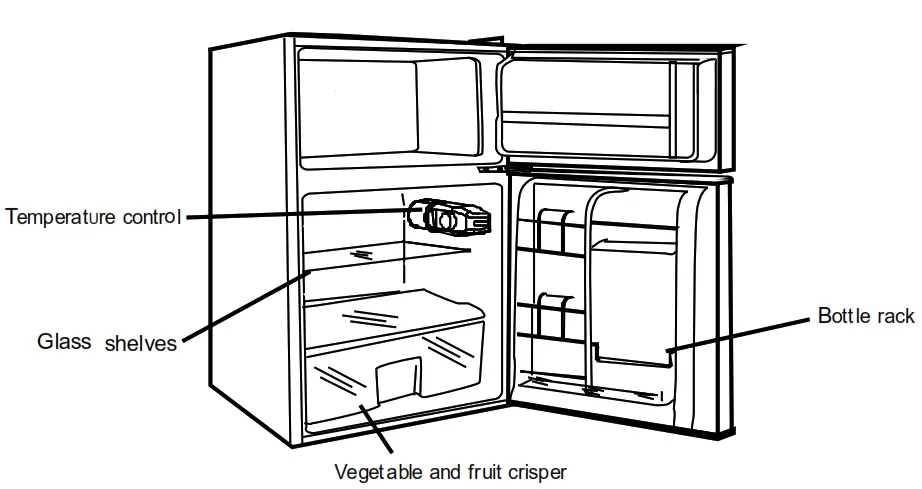 This marking indicates that this product should not be disposed of with other household wastes throughout the EU. To prevent possible harm to the environment or human health from uncontrolled waste disposal, recycle it responsibly to promote the sustainable reuse of material resources. To return your used device, please use the return and collection systems or contact the retailer where the product was purchased. They can take this product for environmentally safe recycling.
This marking indicates that this product should not be disposed of with other household wastes throughout the EU. To prevent possible harm to the environment or human health from uncontrolled waste disposal, recycle it responsibly to promote the sustainable reuse of material resources. To return your used device, please use the return and collection systems or contact the retailer where the product was purchased. They can take this product for environmentally safe recycling.
For more information, please contact the local authority or your retailer where you purchased the product.
ENERGY-SAVING TIPS
- The appliance should be located in the coolest area of the room, away from heat-producing appliances or heating ducts, and out of direct sunlight.
- Let hot foods cool to room temperature before placing in the appliance. Overloading the appliance forces the compressor to run longer. Foods that freeze too slowly may lose quality or spoil.
- Be sure to wrap foods properly, and wipe containers dry before placing them in the appliance. This cuts down on frost build-up inside the appliance.
- Appliance storage bin should not be lined with aluminum foil, wax paper, or paper toweling. Liners interfere with cold air circulation, making the appliance less efficient.
- Organize and label food to reduce door openings and extended searches. Remove as many items as needed at one time, and close the door as soon as possible.

